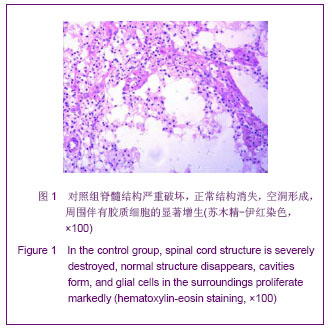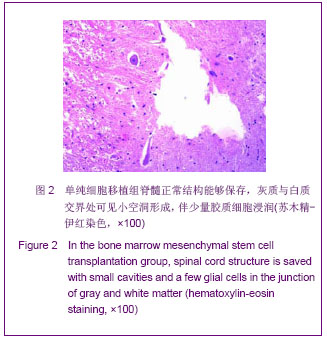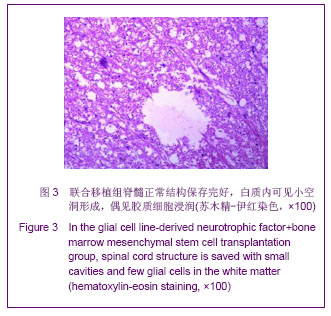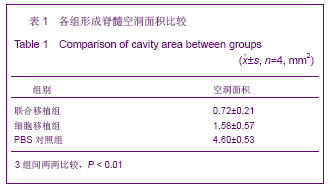| .[1] Sakai K, Yamamoto A, Matsubara K, et al. Human dental pulp-derived stem cells promote locomotor recovery after complete transection of the rat spinal cord by multiple neuro- regenerative mechanisms. J Clin Invest. 2012; 122(1): 80-90.[2] Sahni V, Kessler JA. Stem cell therapies for spinal cord injury. Nat Rev Neurol. 2010;6(7):363-372.[3] Kim BG, Hwang DH, Lee SI, et al. Stem cell-based cell therapy for spinal cord injury. Cell Transplant. 2007;16(4):355- 364.[4] Liu WG, Wang ZY, Li JD, et al. Zhonghua Chuangshang Guke Zazhi. 2011;13(2):165-170.刘文革,王振宇,李建东,等.碱性成纤维细胞生长因子基因修饰的骨髓基质干细胞/乙交酯-丙交酯共聚物复合体对大鼠脊髓损伤的修复作用[J]中华创伤骨科杂志,2011,13(2):165-170.[5] Song CY,Xu H,Chen JM,et al. Zhongguo Zuzhi Gongcheng Yanjiu yu Linchuang Kangfu. 2011;15(23):4316-4320.宋晨阳,徐皓,陈建梅,等.静脉移植CXCR-4基因转染骨髓间充质干细胞在脊髓损伤鼠体内的迁移与分化[J].中国组织工程研究与临床康复,2011,(15):23:4316-4320.[6] Shi RC,Feng DJ,Wang ZG. Zhongguo Zuzhi Gongcheng Yanjiu yu Linchuang Kangfu. 2011;15(19):3507-3512.石瑞成,冯士军,王志刚.高压氧联合神经干细胞移植治疗大鼠脊髓损伤[J].中国组织工程研究与临床康复,2011,15(19):3507- 3512.[7] Deng YB,Yuan QT, Liu XG, et al. Functional recovery after rhesus monkey spinal cord injury by transplantation of bone marrow mesenchymal-stem cell-derived neurons. Chin Med J (Engl). 2005;118(18):1533-1541.[8] Deng YB,Liu XG,Liu ZG, et al. Implantation of BM mesenchymal stem cells into injured spinal cord elicits de novo neurogenesis and functional recovery: evidence from a study in rhesus monkeys. Cytotherapy. 2006;8(3):210-214.[9] Liu XG, Deng YBi,Cai Hui,et al. Zhongguo Kangfu Yixue Zazhi. 2009;24(6):509-511.刘晓刚,邓宇斌,蔡辉,等.诱发电位在GDNF与MSCs联合移植法治疗猴脊髓损伤评价中的应用[J].中国康复医学杂志,2009, 24(6):509-511.[10] Liu XG,Deng YB,Cai H,et al. Zhongguo Zuzhi Gongcheng Yanjiu yu Linchuang Kangfu. 2009;13(32):6219-6222.刘晓刚,邓宇斌,蔡辉,等.控释GDNF与骨髓MSCs源性神经元样细胞移植对猴脊髓髓鞘的修复作用[J].中国组织工程研究与临床康复,2009,13(32):6219-6222.[11] Ding Z,Yang SL. Zhongguo Zuzhi Gongcheng Yanjiu yu Linchuang Kangfu. 2011;15(1):147-150.丁志,杨松林. 间充质干细胞生物学特性及其分化潜能[J]中国组织工程研究与临床康复,2011,15(1):147-150.[12] Sorensen AL,Timoskainen S,West FD, et al. Lineage-specific promoter DNA methylation patterns segregate adult progenitor cell types. Stem Cells Dev. 2010;19(8):1257- 1266.[13] Clabaut A, Delplace S, Chauveau C, et al. Human osteoblasts derived from mesenchymal stem cells express adipogenic markers upon coculture with bone marrow adipocytes. Differentiation. 2010;80(1):40-45.[14] Zhang G, Drinnan CT, Geuss LR, et al. Vascular differentiation of bone marrow stem cells is directed by a tunable three- dimensional matrix. Acta Biomater. 2010;6(9):3395- 3403.[15] Yao J,Bo ZD,Zhang B, et al. Zhongguo Yiyao Daobao. 2008; 5(17):20-21.姚军,薄占东,张斌,等.骨髓间充质干细胞在神经系统损伤修复治疗中的研究进展[J].中国医药导报,2008,5(17):20-21.[16] Park HW, Lim MJ, Jung H, et al. Human mesenchymal stem cell-derived Schwann cell-like cells exhibit neurotrophic effects, via distinct growth factor production, in a model of spinal cord injury. Glia. 2010;58(9):1118-1132.[17] Wang J,Ding F,Gu Y,et al. Bone marrow mesenchymal stem cells promote cell proliferation and neurotrophic function of Schwann cells in vitro and in vivo. Brain Res. 2009;1262:7-15.[18] Alexanian AR,Maiman DJ,Kurpad SN,et al. In vitro and in vivo characterization of neurally modified mesenchymal stem cells induced by epigenetic modifiers and neural stem cell environment. Stem Cells Dev. 2008;17(6):1123-1130.[19] Prabhakaran MP,Venugopal JR,Ramakrishna S. Mesenchymal stem cell differentiation to neuronal cells on electrospun nanofibrous substrates for nerve tissue engineering. Biomaterials. 2009;30(28):4996-5003.[20] Takeda M,Kitagawa J,Nasu M,et al. Glial cell line-derived neurotrophic factor acutely modulates the excitability of rat small-diameter trigeminal ganglion neurons innervating facial skin. Brain Behav Immun. 2010;24(1):72-82.[21] Yasuda T, Mochizuki H. Use of growth factors for the treatment of Parkinson's disease. Expert Rev Neurother. 2010;10(6):915-924.[22] Tsui CC,Pierchala BA. The differential axonal degradation of Ret accounts for cell-type-specific function of glial cell line-derived neurotrophic factor as a retrograde survival factor. J Neurosci. 2010;30(15):5149-5158.[23] Pan SP,Liu Q,Wu D,et al. Shanxi Yike Daxue Xuebao. 2008; 39(6):516-518.潘世鹏,刘强,吴斗.蛛网膜下隙局部应用GDNF对脊髓前角运动神经元的保护作用[J].山西医科大学学报,2008,39(6):516- 518.[24] Kemp K, Hares K, Mallam E, et al. Mesenchymal stem cell-secreted superoxide dismutase promotes cerebellar neuronal survival. J Neurochem. 2010;114(6):1569- 1580.[25] Wang XB,Mao P,Xu YL,et al. Zhongguo Redai Yixue. 2011;11(6):724-726.王小博,毛平,许艳丽,等.人类脐带血MSC和骨髓MSC分泌细胞因子的对比研究[J].中国热带医学, 2011,11(6): 724- 726.[26] Hu HL,Wang GX,Zou C,et al. Zhongguo Zuzhi Gongcheng Yanjiu yu Linchuang Kangfu. 2011;15(32):5995-5998.胡红林,王共先,邹丛,等.骨髓间充质干细胞治疗肾缺血再灌注损伤的旁分泌机制[J].中国组织工程研究与临床康复, 2011, 15(32):5995-5998.[27] Liu R,Fan DY,Jin P,et al. Zhongguo Zuzhi Gongcheng Yanjiu yu Linchuang Kangfu. 2011;15(1):7-11.刘然,范东艳, 金鹏,等. 损伤脊髓匀浆上清对骨髓间充质干细胞分泌髓鞘前脂蛋白、脑源性神经营养因子的影响[J].中国组织工程研究与临床康复,2011,15(1): 7-11.[28] Cheng F,Li LX,Hao HY,et al. Zhongguo Zuzhi Gongcheng Yanjiu yu Linchuang Kangfu. 2010;14(1):1-5.程峰,李立新,郝怀勇,等.骨髓间充质干细胞旁分泌作用与脑缺血后的细胞凋亡[J].中国组织工程研究与临床康复, 2010, 14(1): 1-5.[29] Ye WB,Deng YB,Wang Y,et al. Bone marrow stromal cells (BMSCs) secrete neurotrophic factors and enhance the injured neurological function after MCAo in rats. Jiepouxue Yanjiu. 2010;32(1):10-16.叶伟标,邓宇斌,王晔,等.BMSCs移植后通过分泌神经营养因子对大鼠脑缺血神经功能改善的实验研究[J].解剖学研究,2010, 32(1): 10-16.[30] Liu XG,Deng YB,Cai H. Zhongguo Zuzhi Gongcheng Yanjiu yu Linchuang Kangfu. 2010;14(10):1813-1816.刘晓刚,邓宇斌,蔡辉.碱性成纤维细胞生长因子与猴骨髓间充质干细胞增殖及向神经元前体细胞分化:不同质量浓度对诱导剂隐丹参酮作用有差异吗[J].中国组织工程研究与临床康复, 2010, 14(10):1813-1816. |




